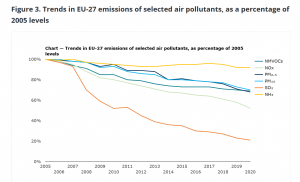 Reducing toxic chemicals and mould is crucial for good indoor air quality in schools.
Reducing toxic chemicals and mould is crucial for good indoor air quality in schools.
Establishing regulations to improve indoor air quality and limit values for common air pollutants in places where sensitive populations gather is a crucial start (Vlaamse Regering, 2004; Lowther et al., 2021; UBA, 2023; Gouvernement de France, 2022).
Clear sources of exposure to indoor air pollutants such as cleaning, painting, etc. should be organised to minimise children’s exposure, by scheduling them to take place after school hours, using low-emission cleaning products and materials, prioritising wet cleaning, fitting vacuum cleaners with HEPA filters, minimising the use of toxic chemicals, and using technologies like sorptive boards (surfaces engineered to trap certain pollutants) and CO2 monitoring in classrooms as an indicator of indoor air quality.
In most school settings, outdoor air quality can be better than indoor air quality on several parameters, and ventilation is a prime tool to improve indoor air quality in classrooms and laboratories. It lowers CO2 levels and the risk of aerosol-transmitted diseases, removes moisture (and associated mould risks — see below), as well as odours and toxic chemicals from construction products, furniture and cleaning agents (Fisk, 2017; Aguilar et al., 2022).
Ventilation of buildings can be improved by:
(1) opening windows and doors to bring in ambient air,
(2) using heating, ventilation, and air conditioning (HVAC) devices, and ensuring exhaust fans in bathrooms and kitchens are working properly, and (3) communicating necessary background knowledge and instructions to students, parents, faculty and staff
(Beregszaszi et al., 2013; European Commission et al., 2014; Baldauf et al., 2015; Jhun et al., 2017; Rivas et al., 2018; Thevenet et al., 2018; Brand et al., 2019; WHO Europe, 2022).
Post time: May-19-2023

